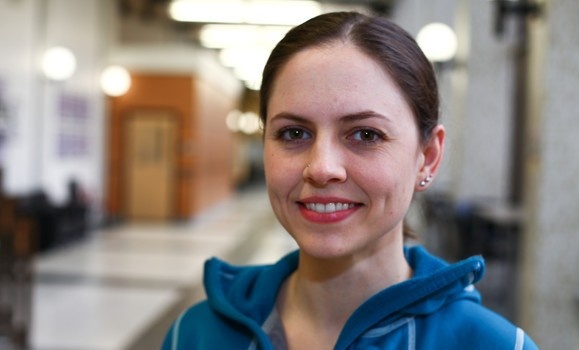Last month, the New York Times’ “Think Like a Doctor” feature gave Dalhousie medicine student Heather Chambers a chance to shine.
The regular column features a difficult medical case and asks readers to try and guess the diagnosis.
Chambers, a third-year student, read about a woman who was taken to a New York City emergency room with an excruciating, seemingly infected leg wound. Despite the best efforts of her doctors, the wound did not respond to antibiotics.
That was all the information Chambers needed. “The answer was right there in the title,” she says. “The issue is one that you wouldn’t suspect until it didn’t respond to treatment.”
The problem was pyoderma gangrenosum, a rare condition that causes tissue to become necrotic and presents itself much like an infected wound. As Chambers points out, its hallmark is that, unlike infection, pyoderma gangrenosum does not respond to antibiotics.
While more than 400 people wrote in to try and answer the question, Chambers was the first to respond with the correct answer.
It was the Dalhousie Medical School’s newly implemented e-learning and online teaching that allowed her to make the diagnosis so quickly. In her second-year dermatology rotation with Dr. Peter Green, Chambers learned about the disease. “The course was taught really well. It incorporated interactive modules, one of which covered this disease. I just looked at the picture and knew.”
A new approach to medical learning
Chambers is part of the first MD class that will graduate under Dal’s new curriculum, launched as part the Faculty of Medicine's renewal process. “It’s a lot more case-based learning, fewer lectures and more small groups,” says Chambers. “Starting in first year, it gets people out to shadow and work in an actual medical position.”
She says the interactive learning tools are key because it means that the professors are thinking about their students. “It’s a good indication of thinking about how to teach. Different people learn differently and it’s important to know that the professor is thinking about that.”
The tools are essential elements of a program designed to produce doctors that “are able to work as agents of creative change in health-care institutions and communities,” she adds.
Doing what she loves
A career in medicine was in the back of Chambers’ mind throughout high school and her undergraduate degree, but she presumed her less-than-confident math skills might hold her back.
It was her experience in the health-care system, after becoming ill during her first career as a public television producer in Oregon, that inspired her to apply to medical school.
“It made me realize that doctors aren’t super-human,” she recalls, “and if they could do it, then why couldn’t I?
“Once I figured that out, I just started taking math classes, and lo-and-behold, I was just too young the first time.”
Chambers is currently in the middle of third-year specialties rotation. “Public television was a lot of long hours too, but it’s different now that I’m doing something I really want to be doing,” she says. “The more I get into it, the more I just feel privileged to be able to participate in peoples’ lives the way I have the ability to, and that I have some way to make things a little better.”

